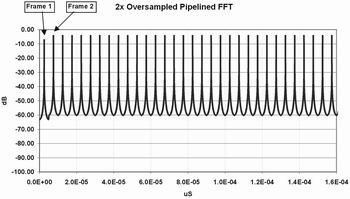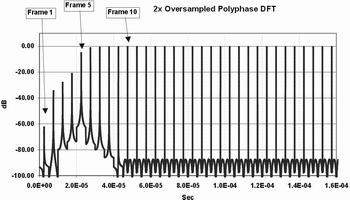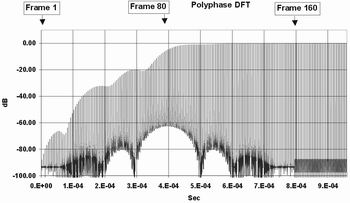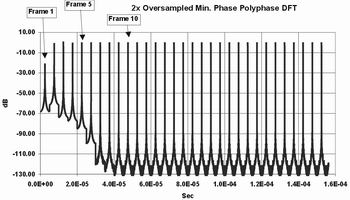Abstract: This article briefly discusses the differences in response between FFT and polyphase DFT filter banks. In general, multi-phase DFT (even including any filter bank, such as PFT) has good adjacent channel suppression performance under steady-state conditions, but the transient response is poor. This is consistent with the filter impulse response conclusion. A simple example of a typical 1024 subband filter bank study illustrates these differences.
Introduction The study of the frequency response of the filter bank is a very complex subject. Most articles in this area only study the response in steady state. In fact, radar and other burst signals have instantaneous characteristics. Therefore, it is very important to understand the instantaneous performance of the filter bank. In general, the better the frequency resolution characteristics, the longer it takes to stabilize. This is because the steeper the filter, the more taps it needs and the longer the impulse response time. Therefore, during the stabilization period, the filter taps are not full, and the frequency response of the adjacent channel is actually worse than the unweighted FFT filter bank.
This article compares FFT and multiphase DFT filter banks, including the steady state and transient conditions. At the same time, the contents of oversampling and the so-called "minimum phase" filter are briefly analyzed.
Frequency response of the filter bank at steady state Comparison of frequency response It is well known that the effective filter response of the pipeline FFT is the Sinx / x (Sinc) function, and for many applications, it does not provide sufficient adjacent channel suppression. Using simple window functions, such as Hanning, Kaiser, Blackman-Harris, etc., can improve the sidelobe suppression of the filter at the cost of a reduced mainlobe width. By designing appropriate filter banks, such as PFT and polyphase DFT, the frequency response characteristics can be improved.
Effective noise bandwidth Another important parameter of filter performance is the effective noise bandwidth (ENB). Table 1 gives a comparison of several filter banks.
It can be seen from Table 1 that the Blackman-Harris window-weighted FFT has good sidelobe suppression, but the loss in signal-to-noise ratio (S / N) exceeds 3dB; and an 8-tap multi-phase DFT (such as an 8 to be described below) The window with multiple transformation lengths) has good side lobe suppression and low effective noise bandwidth, and the signal-to-noise ratio loss is only 1dB.

Figure 1 2 × oversampling, unweighted, 1024 subband pipeline FFT transient response

Figure 2 2 × oversampling, 5-tap, 1024 subband multiphase DFT transient response

Figure 3 Transient response of 32-fold oversampling, 5-tap, 1024 subband multiphase DFT

Figure 4 2 × oversampling, 5 taps, minimum phase, 1024 subband multiphase DFT transient response
General time domain considerations Time domain sampling window For simple window sampling, the number of sampling points in the window is equal to its own transformation length. In order to obtain a better filtering effect, the number of sampling points in the window needs to be greater than the transform length. In theory, the size of the window can be any length. In multi-phase DFT, it is usually an integer multiple of the transform length (2x, 3x, etc.), but in the WOLA implementation, it can be any length. For example, a 1024 subband filter bank may require 4096 input samples (4 times the frame length) as the first full output frame. For the PFT filter bank, the number of sampling points required is equal to the impulse response of the cascade filter, but the actual effect is similar to the number of sampling points required to obtain the first full output frame, far exceeding the frame length.
Oversampling Another factor affecting processing throughput rate is the degree of oversampling required by the output filter. Even if critical sampling is obtained (the sampling rate is exactly equal to the Nyquist rate), overlap processing is required. Using the above example, 4096 samples are required to form the first full output frame of 1024 subbands. To achieve critical sampling means that the next frame of 1024 subbands must be temporally adjacent to the previous frame, and the output sampling rate must be equal to the input sampling rate. This can be achieved by starting the next set of 4096 sampling points with a delay of 1024 sampling points and performing 4 overlapping processes. To achieve oversampling, you need to increase the number of overlaps. Using the above example again, twice the oversampling will require a delay of 4096 samples, and with 8 overlapping processes, only 512 samples are needed to meet the above requirements. PFT usually uses twice the oversampling.
The degree of oversampling is determined by the number M of new samples (parameters for each new transformation). The smaller the value of M, the larger the oversampling factor.
General Parameters for Transient Analysis Although multi-phase, WOLA or PFT filter banks give good adjacent channel suppression performance under steady-state conditions (such as stable signal conditions and all filter taps are full), the transient response is Another situation. In the following discussion, the general parameters used are:
? Number of subbands = 1024
? Input sampling rate = 102.4 MS / s (complex)
? Output sampling rate = 204.8 MS / s (2 times oversampling)
? Number of multi-phase taps = 5 (equivalent to 5120 point window)
? Filter stop band rejection = -85 dB
? Filter passband ripple = 0.2 dB (peak-to-peak)
? Filter overlap = 75%
The last parameter is used to measure the cutoff rate of the filter. The filter is designed so that the edges of the sub-bands are flat and then enter the stop band, which overlaps with the width of the adjacent sub-bands by 75%.
The transient result is generated by a sine wave input step function, with a frequency range shifted from the center frequency to half a subband. It gives the worst spectral leakage for FFT.
In the following, the normalized power spectrum (10 * Log10 {I2 + Q2}) will be introduced, and the output of the pipeline at the rate of 2 times oversampling rate (in this case the rate is 204.8MS / s) will be described. A single 1024-sample frame contains interleaved frequency subbands from s / 2 to + Fs / 2, where Fs is the input complex sampling rate.
FFT transient response Figure 1 shows the transient response of an unweighted FFT. The figure does not show the 1024 samples that need to be collected before the first output and any other "dead" time caused by actual hardware processing. Because it is twice oversampled, the first 1024-point frame has not yet reached a steady state. This can be explained by the fact that the first output frame is generated within 5ms (1024 points are generated at a sampling rate of 204.8MS / s), while the input sampling rate is 102.4MS / s, which means that only 512 samples are Useful (the rest is 0).
Multi-phase DFT transient response Figure 2 shows the 5-tap multi-phase DFT transient response. Obviously, compared with FFT, the transient response time is longer, and it does not reach the steady state completely until the 10th frame. Until the fifth frame, the effective filter frequency response is not as good as the unweighted FFT. This is because the taps of the filter are only half full. It took 10 frames to reach full steady state (5 taps times the oversampling factor).
The effect of oversampling Someone may think that by oversampling at the output of the filter bank can reduce the transient response time, this is not correct. The transient response is the filter impulse response function, and the effect of oversampling only makes the details of the transient response more clear. This can be illustrated by the following example:
? Number of subbands = 1024
? Input sampling rate = 6.4MS / s (complex)
? Output sampling rate = 204.8MS / s (32 times oversampling)
? Number of multi-phase taps = 5 (same effective filtering as above)
Figure 3 shows the transient response of 32 times oversampling. In order to maintain an output sampling rate of 204.8 MS / s (limited by the maximum output rate of the device), the input rate must be reduced to 6.4 MS / s.
The transient response of the 80th and 160th frames in the 32-fold oversampling case corresponds exactly to the 5th and 10th frames in the 2x oversampling case. This clearly shows that oversampling does not gain a time benefit. The first frame of 32 times oversampling is even worse than the first frame of 2 times oversampling, because now only 32 of the 5120 samples are available. By comparing Figure 2 and Figure 3, the nuance of the transient response is clearer (note that the time axis scale is different due to the change in input sampling rate from 102.4 MS / s to 6.4 MS / s).
The effect of the minimum phase FIR filter In this respect, a more accurate name is "minimum group delay filter", because for the IIR filter, the cost of the nonlinear phase response can reduce the group delay of the center band . A typical example is shown in Figure 4.
Except that the filter tap coefficients are different, the other parameters are the same as in FIG. 2. It can be seen that the amplitude response of the filter increases rapidly, but this does not mean that the filter can stabilize more quickly in terms of adjacent channel suppression.
In frame 5 of the minimum phase, although the amplitude has reached the maximum value, the spectral response has not yet reached the steady state condition of frame 9 or 10. The impact in this regard is similar to that of standard multiphase DFT.
Conclusion The conclusion is clear. Fast transient response and steep spectrum filters cannot be obtained at the same time. The fastest settling time can be obtained from a simple FFT (weighted or unweighted), at the cost of relatively poor spectral filtering characteristics. From another aspect, the step response of the Sinx / x FFT filter is very close to the immediate step response.
When referring to a "brick wall" filter, the designer must accept the resulting transient response delay due to the filter being full. The steeper the filter, the longer the transient time. If priority is given to the signal amplitude of the given subband, the "minimum phase" filter will help, but this does not improve (in fact, it may deteriorate) the adjacent channel suppression performance during transients. This also brings a nonlinear phase response for each subband.
Oversampling plays a role in showing more details during transients, but it does not shorten the transient response time.
A-class lithium cells
Superior selection for materials & parts
Exquisite workmanship
High-quality handicraft grade look and workmanshipHigh class ABS container with abrasive coating
High class brass terminals make low internal resistance and strong discharge performance
Convenient installation in Motorcycle.
LiFePO4 Motorcycle Starting Batteries
Motorcycle Battery,Lithium Motorcycle Battery,Motorcycle Starting Batteries,LiFePO4 Batteries
Starlight Power Industrial Company Limited , https://www.starlite-power.com